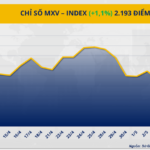The VN-Index witnessed increased selling pressure in the two sessions following its strong surge past the 1,240-point mark on Monday. The benchmark index briefly dipped towards the 1,200-point support level before bottom-fishing forces helped it recover in the last two sessions of the week. The VN-Index ended the week at 1,219 points, a slight decrease of over 3 points compared to the previous week’s close.
Foreign trading was a downside last week as they net sold unexpectedly. In total, after five sessions, foreign investors net sold VND5,170 billion on the entire market, focusing on selling over VND4,500 billion in the Thursday session.

“Catching the market wave” is becoming more unpredictable than ever
Discussing the general context, Mr. Bui Van Huy, Executive Director of Ho Chi Minh City Branch – DSC Securities Joint Stock Company, Chairman of One IBC , stated that the global context is witnessing numerous fluctuations, and major stock indices, after recovering from Mr. Trump’s temporary suspension of tariffs, are now correcting and diverging. In the US, the bond market is being sold off, and the Dollar is unexpectedly weakening (DXY index); the Fed is in a dilemma between inflationary risks and recession.
Domestically, after the “collapse” due to tariff-related news, the market recovered quickly, but according to Mr. Huy, this was a rapid rebound after a deep decline, without accumulation, and there are still many uncertainties in the context. The long-term and short-term trends are currently still bearish. After the rebound, the market is re-accumulating in the 1,200-1,240-point range, and in the most positive case, the market will hold this range to balance psychology.
Regarding the picture of first-quarter profits, Mr. Huy opined that the financial statements do not yet reflect the risks and changes in the business environment. The first quarter of 2025 is not a quarter for the market to expect explosive profits but a transitional period to clearly identify businesses with real resilience in the changing economic environment. The picture of first-quarter financial results will likely show a positive recovery in some leading sectors but also reflect the increasing polarization within the market. Groups such as banks, industrial real estate, steel, and public investment are expected to perform better than the general level, while industries associated with domestic consumption and traditional exports such as textiles, seafood, and wood continue to face pressure from weak demand and input costs.
Notably, the market is currently facing a “growth gap” – with an unpredictable global market context, uncertain output recovery, input costs that have not decreased proportionally, and cautious credit absorption. In such circumstances, the first quarter is no longer a race for profit figures at all costs but focuses on maintaining operations, stability, and controlling expenses. This is when the market looks at the quality of operations, such as the ability to pivot business models, reduce borrowing costs, or optimize inventory rather than just the final net profit figure. Businesses with stable cash flow, low debt, or control over output and input will surely be highly valued by the market in this phase.
Especially after the first-quarter financial results and the General Meeting of Shareholders, the market will lack momentum and weaken, and any scenario can happen at this point. According to Mr. Huy, the second quarter will be a real test for the market, not to expect explosive profit growth but to assess the adaptability and resilience of businesses in a rapidly changing environment. He suggested that investors need to change their perspective and, instead of expecting short-term recovery stories, focus on selecting businesses with sustainable models, less dependent on FDI or exports, and able to maintain profit margins amid challenges.
If the VN-Index breaks below the 1,200-point threshold again, the expert believes that sell-offs will inevitably recur. Currently, portfolio restructuring and risk management are still prioritized over profit-seeking, and it is essential to maintain a relatively high level of cash to cope with any situation.
The current market does not favor impatience or expectations of a synchronized recovery. This phase requires investors to maintain a certain level of cash, raise standards for stock selection, and tighten portfolio management discipline. With a macroeconomic context full of variables, “catching the market wave” is becoming more unpredictable than ever.
“This is the time to restructure industries, focusing on businesses benefiting from strong government support, stable business models, less dependent on exports or FDI, strong cash flow, and stable profit margins across cycles. These stocks are the pillars to control risks and maintain portfolio sustainability in a volatile market,” the expert recommended.
First-quarter financial results as a catalyst to improve investor sentiment and stock valuations
According to Mr. Dinh Quang Hinh, Head of Macroeconomics and Market Strategy, VNDIRECT Research Division , the market’s correction after touching the resistance level of 1,240 points is healthy to absorb some of the bottom-fishing positions. The market is gradually forming a balance between supply and demand at the 1,200-1,250-point range after a period of strong price fluctuations. In the latter part of April, the market will shift its focus to the picture of first-quarter financial results. In the context of the market having entered the “cheap valuation” zone, positive information about financial performance can be a catalyst to improve investor sentiment and stock valuations. Businesses with expected positive results will attract market attention and capital inflows.
Discussing sectors with promising prospects, Mr. Hinh stated that with the recent bright credit growth figures and the cooling down of deposit interest rates, the banking sector is expected to record positive growth in the first quarter of this year. Along with this, the growth of the consumption-retail sector is expected to accelerate as domestic purchasing power shows clear signs of improvement thanks to enhanced consumer income and the government’s stimulus policies. Other sectors anticipated to report favorable financial results include animal husbandry, seafood, and electricity.
Regarding trading strategies, the VNDirect expert advised investors to take advantage of the market’s accumulation phase to restructure their investment portfolios, considering increasing stock proportions during the market’s corrective sessions towards the 1,200-point support zone. He recommended focusing on fundamental stocks in sectors with promising first-quarter financial results, such as banking, retail, animal husbandry, seafood, and electricity. However, leveraging is still not encouraged in the current phase, given the persistent risk of tariffs and the market’s inability to establish a sustainable upward trend.
The VN-Index Surges Past 1,200 Points: Experts Predict a Market Rebound
The stock market is expected to continue its recovery trend next week, with key indices remaining above the 1,200-point mark. Bank stocks, consumer staples, and retail sectors are expected to be in focus, with potential for strong gains. As investors eye these sectors, the market sentiment is likely to remain positive, building on the recent momentum.










































